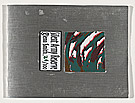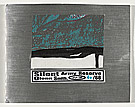Zines
In 2010, zines are one of the most vibrant forms of underground creative expression, with a rapidly expanding network of Australian zine makers and zine collecting enthusiasts. Zines perfectly epitomise the do-it-yourself ethos that is central to the larger national street art scene. While many street artists and their multiple forms of street-based expression have been circumscribed by the authorities, the inconspicuous zine continues to defy categorisation, censorship and regulation.
By their very nature, zines revolt against the aesthetic of the mass-produced, big-budget, commercially controlled and globally marketed publication, to embrace an honest aesthetic of the cut-and-paste technique, self-published, self-promoted and limited edition. As the ultimate form of lo-fi mass communication and image dissemination, zines are truly anti-establishment and a creative expression by the people for the people. Through the combination of pen, paper and most commonly, a photocopier, even the most simply created zine becomes a unique mix of the intimate and the multiple, the handmade and the mechanical and the ephemeral and the collectable.
The zine makers involved in the exhibition Space invaders display a wide variety of inventive techniques and approaches. The Australian zine culture is a vital community of contemporary, creative energies, actively reshaping Australian visual culture from its grassroots.
Underground, elusive, ephemeral. Zines are humble and proud at the same time; they are loud and quiet, powerful, empowering and powerless, legendary and forgotten, tangible but invisible, plentiful but hidden, spontaneous, subversive, innocent and naive. This is the enigmatic world of Australia’s thriving zine culture, an art form that bypasses galleries, museums, publishing houses, libraries and, most of the time, mainstream consciousness.
Eloise Peace, The Sticky Institute
Interview
Jaklyn Babington, Curator of Space Invaders in conversation with Tim Danko, Australian born, New Zealand living, comic maker and zine maker.
Tim, what was it about comics and zines that initially interested you in experimenting with this underground creative form? The National Gallery of Australia holds the Silent Army comic anthologies in its collection. Can you tell us a little bit about your past involvement with the comic collective Silent Army?
Gregory Mackay, Kieran Mangan and Michael Fikaris began Silent Army and drafted together a fairly tight group of like-minded people working in comics in Australia at the time (mid-1990s to 2000). While Kieran, Greg and Michael had supreme editorial and creative control with the books and various Silent Army exhibitions and events, they drew on a wider group of artists for help with exhibitions and events. We were all comic makers that wanted to push the boundaries of what comics can do. Everyone in the Silent Army books had total creative freedom for their individual pages; if you were asked to participate you were given creative autonomy and trusted to deliver great pages.
From 2000 on Silent Army had closer ties with street art through Andy Mac and Citylights http://citylightsprojects.com/category/artists/tim-danko?page=1, also through some of the Empty Shows that were organised. The Silent Army collective made it possible for people outside of comics to get a sense of who we were as a group and what we were about. Opportunities outside of regular comic avenues became available through the ease of dealing with a collective.
DeadXeroxPress is your own ‘creative label’. How do you distribute your DeadXeroxPress? Have you developed a ‘fan-base’ for your publications?
DeadXerox has always been an organic entity, starting as an imprint for my own efforts and in the early 1990s as a distribution mail order service for small press comix from here and overseas. At the time I was hoping to provide a little focus for a disparate group of comic makers around Australia. Silent Army has had a much greater impact in books published, events staged, and connections made. DeadXerox could be quietly forgotten or nicely remembered. I would like that.
We have three issues of your most recent comic project ’Sup Ho in the Space Invaders exhibition—tell us about that and why you chose the comparatively laborious process of screen-printing.
I wanted to make a superhero comic, to experience the process of making a superhero comic and I think in the end it became a Hasil Adkins http://en.wikipedia.org/wiki/Hasil_Adkins approach to making a superhero comic. I could see from the outside how superhero comics should look but had no idea how it is done in reality so I made up the process from looking and imagining from the outside. I knew someone writes the story and another person draws the art for superhero comics so I found words that were outside and around me (what my five year olddaughter was saying, random parts from a book of quotations, what was on television). I like that the chance words create meanings outside of my conscious intentions.
I also remembered how American comics were reprinted in odd two or three colour processes in Australia when I was a kid and wanted the ‘Sup-Ho’ books to remember that too. A large part of my choices to do with ‘Sup-Ho’ were about what was sustainable for me personally (rather than in the usual environmental sense) so I could draw and print a comic in a six week period whilst looking after my daughter and maintaining our home. I didn’t want the perfect reproduction of a copier; I also wanted to see the chances created by ‘bad’ printing. Screen printing felt like remembering something once removed in the process, which is something I like about comics reprinted or redrawn in countries other than the U.S.A. I used a lot of found or cheap paper that had strong tactile qualities and would cause printing slippage or drift, and hopefully reflected some of the qualities of the superhero character in each book (each ‘Sup-Ho’ is a remembering of a different superhero type). I love the cheap ephemeral ‘low’ nature of comics and wanted ‘Sup-Ho’ to be that too, right down to the materials for reproduction. Being on a small island meant that screen printing an A3 sheet in my garage that gets folded down to a 16 page comic was faster and more immediate than colour photocopying. Physically pushing the ink through the stencil when printing was very close to the actual drawing process of the comics themselves, they were very tactile and physical to draw. Screen printing just feels better all round, I love doing it.
I’m sure as a comic maker and a zine maker you are also a collector. I would love to hear about your personal favourite Australian comics and zines and why you rank them as your favourites?
I always remember the first self published comics I came across because you felt like you were no longer out there alone. Neale Blandens ‘Beautiful Artform’, Gerard Ashworth ‘Weird Stress Kittens’, Mandy Ord’s ‘Wilnot’ and Q-Rays ‘Alcoholo-caust’ are all that I hold dear to my heart because they are entwined with personal experiences about finding my feet with creating my own comics, and meeting the people who made them, beginning to feel like part of a community. Beyond that all of these comics have strong personal visions and are bristling with creative energy.
I do remember Lachlan Conn’s ‘Pumpkin Moon’ as being a beautiful comic that opened my eyes to the amazing achievements possible with limited resources, as well as a comic that could be read in an open way. Oats comics in New Zealand have shown me how to enjoy the process of making comics again. They are comics that embrace lowbrow sources intelligently and celebrate the ordinary in a beautiful way, and are obviously just plain fun to make and more fun to read. G-frenzy’s ‘Choice Guy’, Stefan Neville and Clayton Noones ‘City of Tales’ series, Indira Neville’s ‘Nice Gravy’ and the Oats anthology ‘Dad and Tracy’. I think self publishing is a highly personal medium and for me it is impossible to separate personal experiences from any objective quality of the comic.
My favourite ‘zine’ or ‘comic’ of all time is Amos ‘Bad Heart’ Bull’s ‘History of the Oglala Sioux’. He survived the battle of Little Big Horn and drew the story of his tribe in an old army ledger he purchased from a reservation trader. The book was eventually buried with his sister.













